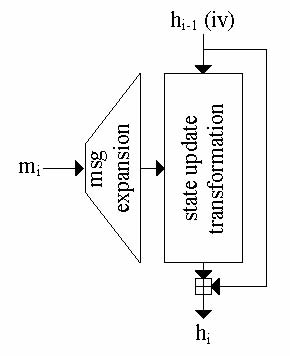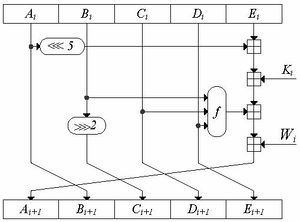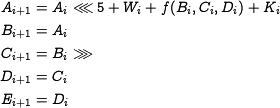SHA-1
Contents
1 NEW APPROACH also called reduce effort :-)
We can try to give the basic infrmation: so block size general construction of compression functions etc. NO DETAILS. Just reference to the paper proposing the hash function. Then we list the attacks or preliminary analyses. We give the abstract and our opinion about this attack. For instance 2nd-preimages in much less than 2n. Opinion could be: very nice observation, generic, but still not practical since extreme message lengths are required.
I think we should go this way. Esecially we should clearly say what is
- broken
- wounded
- ?
- etc.
2 General Description
SHA-1 is an iterated hash function. It can be used to compute a 160-bit hash value for messages having a length of less than 264 bits, cf. FIPS 180-2 Secure Hash Standard. As most iterated hash functions, SHA-1 applies MD strengthening.
2.1 Compression Function
The compression function processes input message blocks of 512 bits and
produces a 160-bit chaining value. The compression function of
SHA-1 basically consists of two parts: the message expansion and
the state update transformation. The chaining variable  (iv in the first iteration) is added to the output of the state update transformation (feed forward).
(iv in the first iteration) is added to the output of the state update transformation (feed forward).
2.1.1 Message Expansion
In SHA-1, the message expansion is defined as follows. A single
512-bit input message block block is represented by 16 32-bit
words, denoted by  , with
, with  . The message input is linearly expanded into 80 32-bit words
. The message input is linearly expanded into 80 32-bit words  defined as follows:
defined as follows:
2.1.2 State Update Transformation
The state update transformation starts from a fixed initial value
iv for 5 32-bit registers  (also
referred to as state variables) and updates these registers in 80
steps (
(also
referred to as state variables) and updates these registers in 80
steps ( ) by using the word
) by using the word  and the step
constant
and the step
constant  in step
in step  . One step of the state update transformation is defined as
. One step of the state update transformation is defined as
The function  depends on the step number: steps
depends on the step number: steps  use the IF-function referred to as
use the IF-function referred to as  and steps
and steps  use the MAJ-function referred to as
use the MAJ-function referred to as  . The
remaining steps, use a 3-input XOR referred to as
. The
remaining steps, use a 3-input XOR referred to as  . The Boolean functions are defined as follows:
. The Boolean functions are defined as follows:
2.2 Padding Method
2.3 Constants and Initial Value
2.3.1 Constants
2.3.2 Initial Value
3 Claimed/Expected Security Margins
4 Security Anaylsis
- Best know attack: 263 by Wang et.al.
- Best known collision example: 64-step collision by De Canniere and Rechberger
something like: best know attack to date: kind of attack, which variant has been looked at (e.g. round-reduced), complexity, and reference to paper and abstract.
may be make here a new page with the other cryptanalysis results.






